1988 PONTIAC FIERO ignition
[x] Cancel search: ignitionPage 531 of 1825
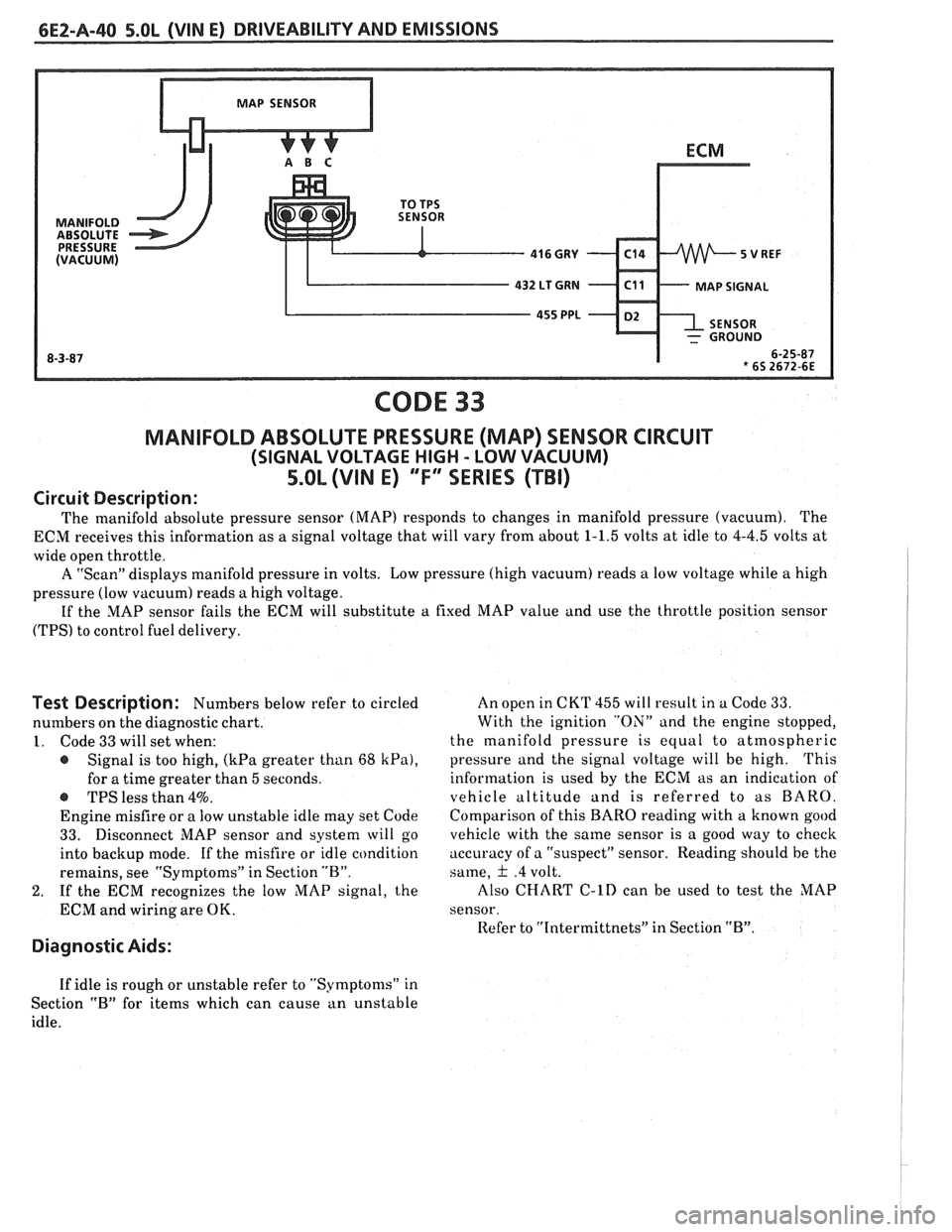
6EZ-A-40 5.0L (WIN E) DRIVEABILITY AND EMISSIONS
CODE 33
MANIFOLD ABSOLUTE PRESSURE (MAP) SENSOR CIRCUIT
(SIGNAL VOLTAGE HIGH - LOW VACUUM)
5.OL (VIN E) "F" SERIES (TBI)
Circuit Description:
The manifold absolute pressure sensor (MAP) responds to changes in manifold pressure (vacuum). The
ECM receives this information as a signal voltage that will vary from about
1-1.5 volts at idle to 4-4.5 volts at
wide open throttle.
A "Scan" displays manifold pressure in volts. Low pressure (high vacuum) reads
a low voltage while a high
pressure (low vacuum) reads a high voltage.
If the MAP sensor fails the ECM will substitute
a fixed MAP value and use the throttle position sensor
(TPS) to control fuel delivery.
Test Description: Numbers below refer to circled
numbers on the diagnostic chart.
1. Code 33 will set when:
@ Signal is too high, (kPa greater than 68 kPa),
for a time greater than 5 seconds.
-S TPS less than 4%.
Engine misfire or a low unstable idle may set Code
33. Disconnect MAP sensor and system will go
into backup mode. If the misfire or idle condition
remains, see "Symptoms" in Section "B".
2. If the ECM recognizes the low MAP signal, the
ECM and wiring are OK.
Diagnostic Aids:
An open in CKT 455 will result in a Code 33.
With the ignition "ON" and the engine stopped,
the manifold pressure is equal to atmospheric
pressure and the signal voltage will be high.
This
information is used by the ECM as an indication of
vehicle altitude
and is referred to as BARO.
Comparison of this
BARO reading with a known good
vehicle with the same sensor is a good way to check
accuracy of a "suspect" sensor. Reading should he the
same,
& .4 volt.
Also
CHART C-lD can be used to test the MAP
sensor.
Refer to
"Intermittnets" in Section "B".
If idle is rough or unstable refer to "Symptoms" in
Section
"B" for items which can cause an unstable
idle.
Page 533 of 1825

6EZ-A-42 5.OL (VIN E) DRIVEABILITY AND EMISSIONS
CODE 34
MANIFOLD ABSOLUTE PRESSURE (MAP) SENSOR CIRCUIT
(SIGNAL VOLTAGE LOW - HIGH VACUUM)
5.OL (VIN E) ""F-SERlES (TBI)
Circuit Description:
The manifold absolute pressure sensor (MAP) responds to changes in manifold pressure (vacuum). The
ECM receives this information as a signal voltage that will vary from about 1-1.5 volts at idle to 4-4.5 volts at
wide open throttle.
If the MAP sensor fails the ECM will substitute a fixed MAP value and use the throttle position sensor
(TPS) to control fuel delivery.
Test Description: Numbers below refer to circled
numbers on the diagnostic chart.
1. Code 34 will set when:
e Signal is too low (kPa less than 14) and engine
running less than 1200 rpm.
OR
@ Engine running greater than 1200 rpm.
e Throttle position greater than 21% (over 1 5
volts).
2. If
the ECM recognizes the high hIAP signal, the
ECM and wiring are OK.
3. The "Scan" tool may not display 12 volts. The
important thing is that the ECM recognizes the
voltage as more than 4 volts, indicating that tho
ECM and CKT 432 are OK.
Diagnostic Aids:
An intermittent open in CKTs 432 or 416 will
result in a Code 34.
With the ignition "ON" and engine stopped, the
manifold pressure is equal to atmospheric pressure
and the signal voltage will be high. This information
is
used by the ECM as an indication of vehicle altitude
and is referred to as BARO. Comparison of this BARO
reading with a known good vehicle wilh the same
sensor is a good way to check accuracy of a "suspect"
sensor.
Iteading shoulci be the same, + .4 volts.
Refer to "Intermittnets" in Section "B".
Page 534 of 1825
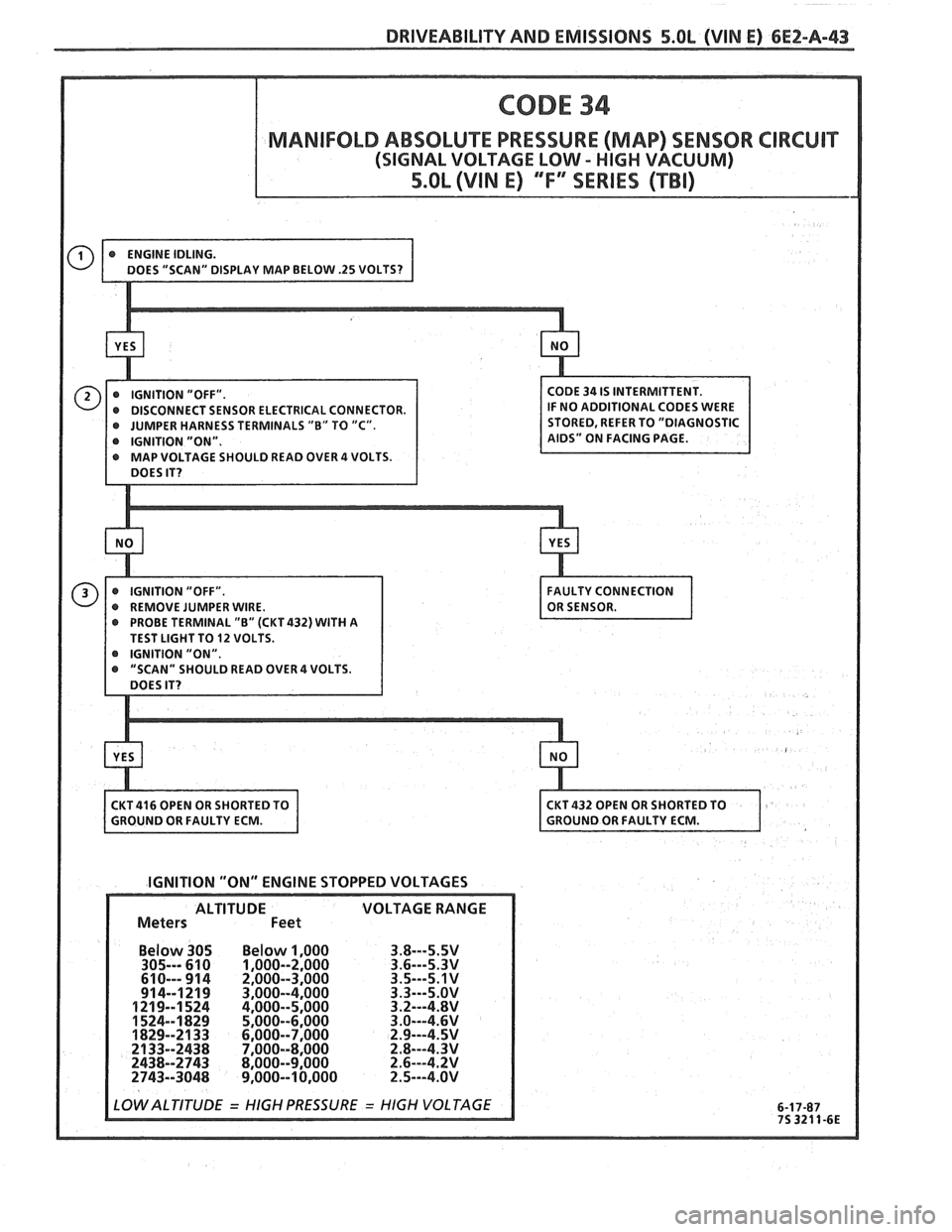
DRIVEABILITY AND EMISSIONS 5.OL (VIN E) 6E2-A-43
CODE 34
MANlFOLD ABSOLUTE PRESSURE (MAP) SENSOR CIRCUIT
(SIGNAL VOLTAGE LOW - HIGH VACUUM)
5.OL (VIN E) ""IF" SERIES (TBI)
ENSOR ELECTRICAL CONNECTOR.
ESS TERMINALS "B" PO "C".
SHOULD READ OVER 4 VOLTS.
AL
"B" (CKT432) WITH A
IGNITION "ON" ENGINE STOPPED VOLTAGES
Below 305 Below 1,000
305--- 610 1,000--2,000
61 0--- 91 4 2,000--3,000
91 4--1219 3,000--4,000
1219--1524 4,000--5,000
1524--1829 5,000--6,000
1829--2133 6,000--7,000
21
33-2438 7,000--8,000
2438--2743 8,000--9.000
2743--3048 9,000--10,000
Page 535 of 1825
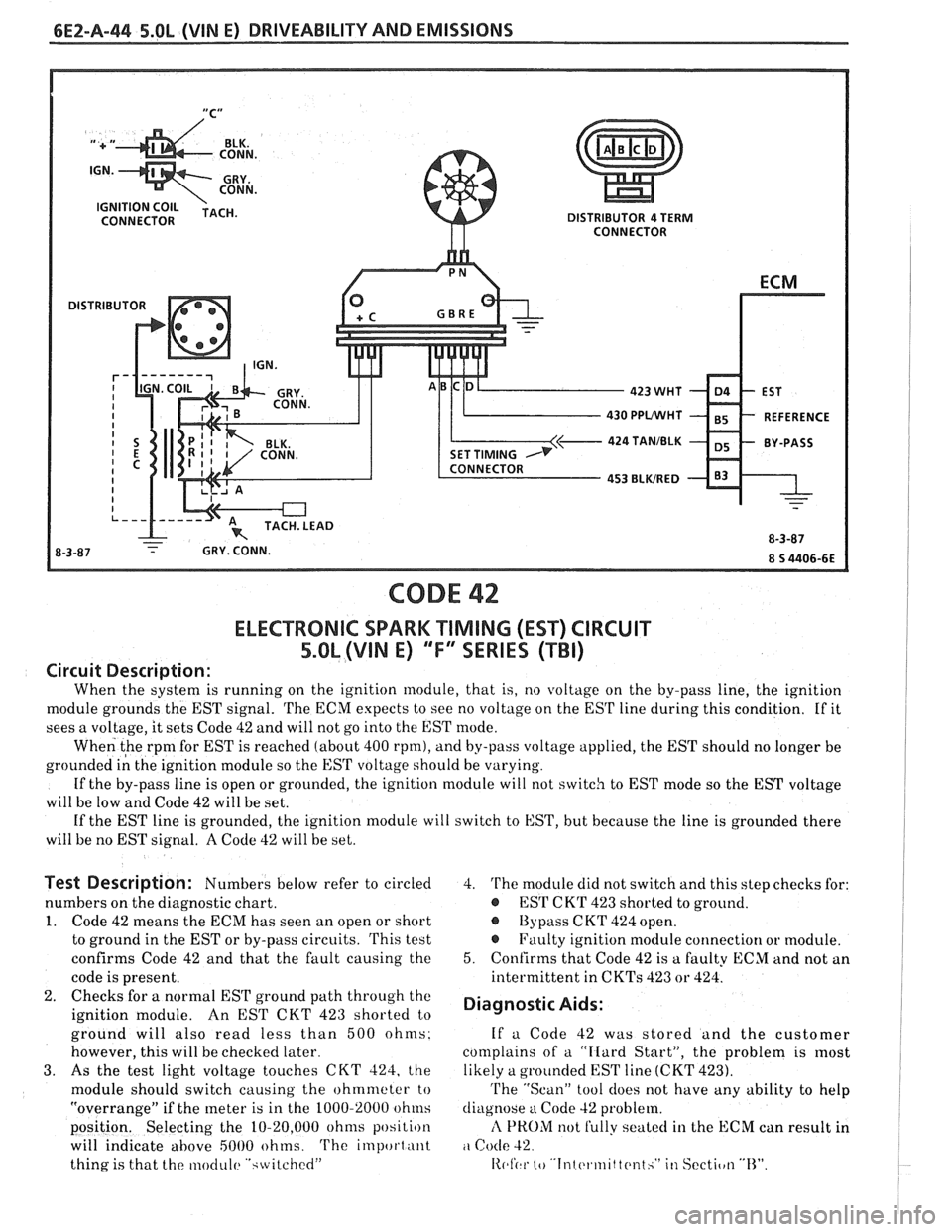
6E2-A-44 5.OL (WIN E) DRIVEABILITY AND EMISSIONS
DISTRIBUTOR 4 TERM
CONNECTOR
DISTRIBUTOR
430 PPVWHT
424 TANIBLK
CODE 42
ELECTRONlC SPARK TIMING (EST) CIRCUIT
5.OL (VIN E) ""FYSERIES (TBI)
Circuit Description:
When the system is running on the ignition module, that is, no voltage on the by-pass line, the ignition
module grounds the EST signal. The ECM expects to see no voltage on the EST line during this condition. If it
sees a voltage, it sets Code 42 and will not go into the EST mode.
When the
rpm for EST is reached (about 400 rpm), and by-pass voltage applied, the EST should no longer be
grounded
i; the ignition module so the EST voltage should be varying.
If the by-pass line is open or grounded, the ignition module will not
switcli to EST mode so the EST voltage
will be low and Code 42 will be set.
If the EST line is grounded, the ignition module
will switch to EST, but because the line is grounded there
will be no EST signal.
A Code 42 will be set.
Test Description: Numbers below refer to circled
numbers on the diagnostic chart.
1. Code 42 means the ECM has seen an open or short
to ground in the EST or by-pass circuits. This test
confirms Code 42 and that the fault causing the
code is present.
2. Checks for a normal EST ground path through the
ignition module.
An EST CKT 423 shorted to
ground will also read less than 500 ohms.
however, this will be checked later.
3. As the test light voltage touches CKT 424, the
module should switch causing the ohmmeter
to
"overrange" if the meter is in the 1000-2000 ohnls
position. Selecting the 10-20,000 ohms position
will indicate
above 5000 ohms. The important
thing is that the moclul(~ ".;~vitched"
4. The module did not switch and this step checks for:
@ ES'I' CKT 423 shorted to ground.
@ By pass C KT 424 open.
@ Faulty ignition module connection or module.
5. Confirms that Code 42 is a faulty ECM and not an
intermittent in
CKTs 423 or 424.
Diagnostic Aids:
If a Code 42 was stored and the customer
complains of
a "IIard Start", the problem is most
likely a grounded EST line (CKT 423).
'I'he "Scan" tool does not have any ability to help
diagnose
a Code 42 problem.
rl PROM not Sully seated in the ECM can result in
Code 42
11~1'(.1- 10 '.In1 c.l.lnlt tc~nth" in Sectiotl "13".
Page 537 of 1825
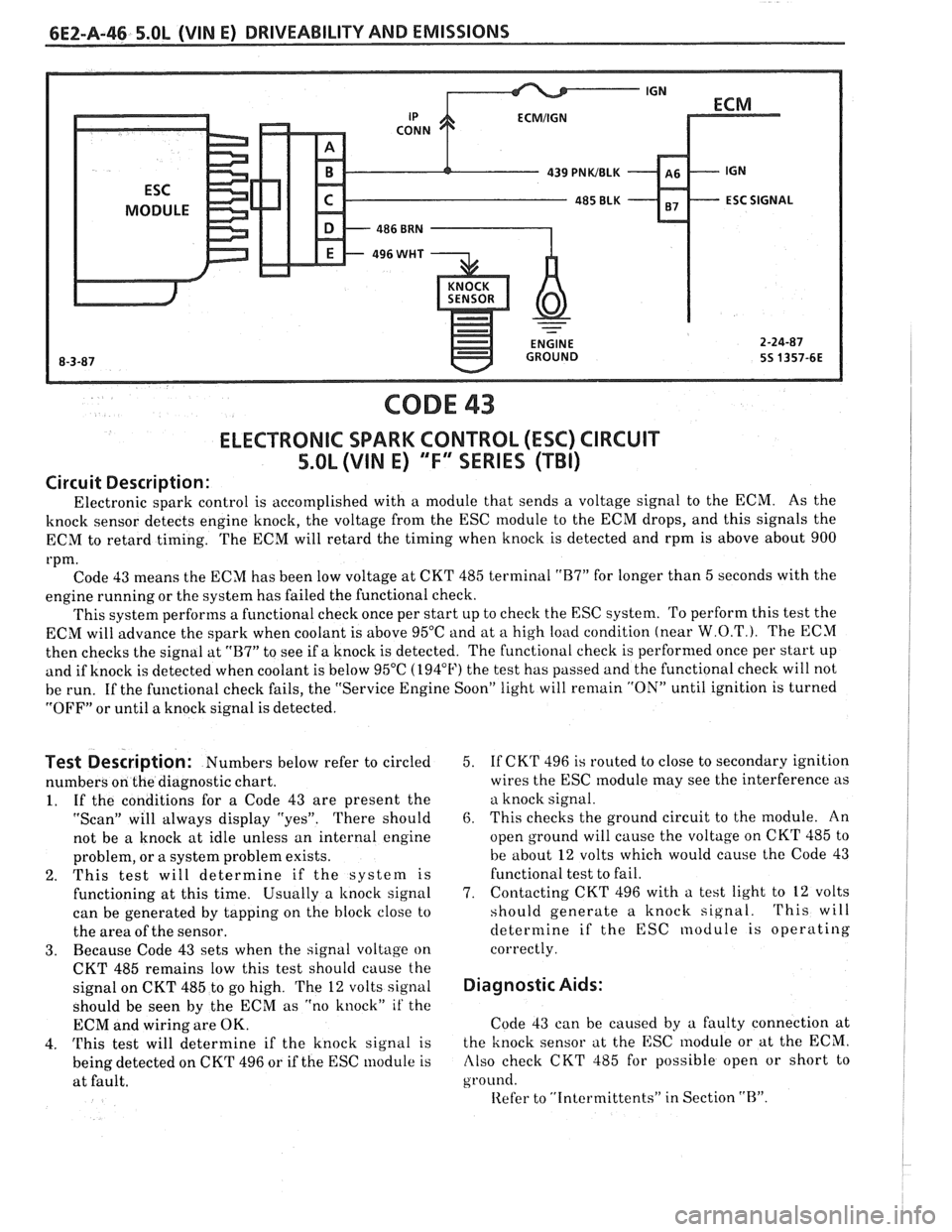
CODE 43
ELECTRONIC SPARK CONTROL (ESC) CIRCUIT
5.0L (VIN E) "F" SERIES (TBI)
Circuit Description:
Electronic spark control is accomplished with a module that sends a voltage signal to the ECM. As the
knock sensor detects engine knock, the voltage from the ESC module to the ECM drops, and this signals the
ECM to retard timing. The ECM will retard the timing when knock is detected and rpm is above about 900
rpm. Code 43 means the ECM has been low voltage at CKT 485 terminal
"B7" for longer than 5 seconds with the
engine running or the system has failed the functional check.
This system performs a functional check once per start up to check the ESC system. To perform this test the
ECM will advance the spark when coolant is above 95°C and at
a high load condition (near W.O.T.). The ECM
then checks the signal at
"B7" to see if a knock is detected. The functional check is performed once per start up
and if knock is detected when coolant is below 95°C (194°F) the test has passed and the functional check will not
be run. If the functional check fails, the "Service Engine Soon" light will
remain "ON" until ignition is turned
"OFF" or until a knock signal is detected.
Test Description: Numbers below refer to circled
numbers on the diagnostic chart.
1. If the conditions for a Code 43 are present the
"Scan" will always display "yes". There should
not be a knock at idle unless an internal engine
problem, or a system problem exists.
2. This test will determine if the system is
functioning at this time. Usually a
knock signal
can be generated by tapping on the block close to
the area of the sensor.
3. Because Code 43 sets when the signal voltage on
CKT 485 remains low this test should cause the
signal on CKT 485 to go high. The
12 volts signal
should be seen by the ECM as "no knock"
it' the
ECM and wiring are OK.
4.
This test will determine if the knock signal is
being detected on CKT 496 or if the ESC module is
at fault. 5.
If
CKT 496 is routed to close to secondary ignition
wires the ESC
module may see the interference as
a knock signal.
6. This checks the ground circuit to the module. An
open ground will cause the voltage on CKT 485 to
be about
12 volts which would cause the Code 43
functional test to fail.
7. Contacting
CKT 496 with a test light to
12 volts
should generate a knock signal.
This will
determine if the ESC nodule is operating
correctly.
Diagnostic Aids:
Code 43 can be caused by a faulty connection at
the knock sensor at the ESC
lnodule or at the ECM.
Also check CKT 485 for possible open or short to
ground.
Iiefer to "Intcrmittents" in Section "B".
Page 541 of 1825

6EZ-A-50 5.0b (VIN E) DRIVEABILITY AND EMISSIONS
- GROUND -
CODE 45
OXYGEN SENSOR CIRCUIT
(RICH EXHAUST INDICAnEB)
5.OL (VlN E) ""FYESEBIES (TBI)
Circuit Description:
The ECM supplies a voltage of about .45 volt between terminals "D6" and "D7". (If measured with a 10
megohm digital voltmeter, this may read as low as .32 volts.) The
O2 sensor varies the voltage within a range
of about
1 volt if the exhaust is rich, down through about .10 volt if exhaust is lean.
The sensor is like an open circuit and produces no voltage when it is below about 360°C (600°F). An open
sensor circuit or cold sensor causes "Open Loop" operation.
Test Description: Numbers below refer to circled
numbers on the diagnostic chart.
1. Code 45 is set when the O2 sensor signal voltage or
CKT
422.
@ Remains above .7 volts for 50 seconds; and in
"Closed Loop".
@ Engine time after start is 1 minute or more.
@ Throttle angle greater than 2% (about .2 volts
above idle voltage) but less than 25%.
Diagnostic Aids:
Using the "Scan", observe the block learn values at
different rpm conditions to determine when the
Code
45 may have been set. If the conditions for Code 45
exists, The block learn values will be around 115.
@ Fuel Pressure System will go rich if pressure is too
high. The ECM can compensate for some increase.
However, if it gets too high, a Code 45
may be set.
See "Fuel System Diagnosis", CHART
A-7.
Q See CHART A-7.
@ Check for fuel contaminated oil.
@ HE1 Shielding An open ground CKT 453 (ignition
system ref. low) may result in EMI, or induced
electrical "noise". The ECM looks
at this "noise" as
reference pulses. The additional pulses result in a
higher than actual engine speed signal. The ECM
then delivers too much fuel, causing system to go
rich. Engine tachometer will also show higher than
actual engine speed, which can help in diagnosing
this problem.
@ Canister Purge Check for fuel saturation. If full of
fuel, check canister control and hoses. See
"Canister Purge", Section
"(23".
@ MAP Sensor An output that causes the ECM to
sense a lower than normal
vacuum can cause the
system to go rich. Disconnecting the MAP sensor
will allow the ECM to set
a fixed value for the
sensor. Substitute a different MAP sensor if the the
rich condition is gone while the sensor is
disconnected.
r TPS An intermittent TPS output will cause the
system to go rich, due to
a false indication of the
engine accelerating.
Page 543 of 1825
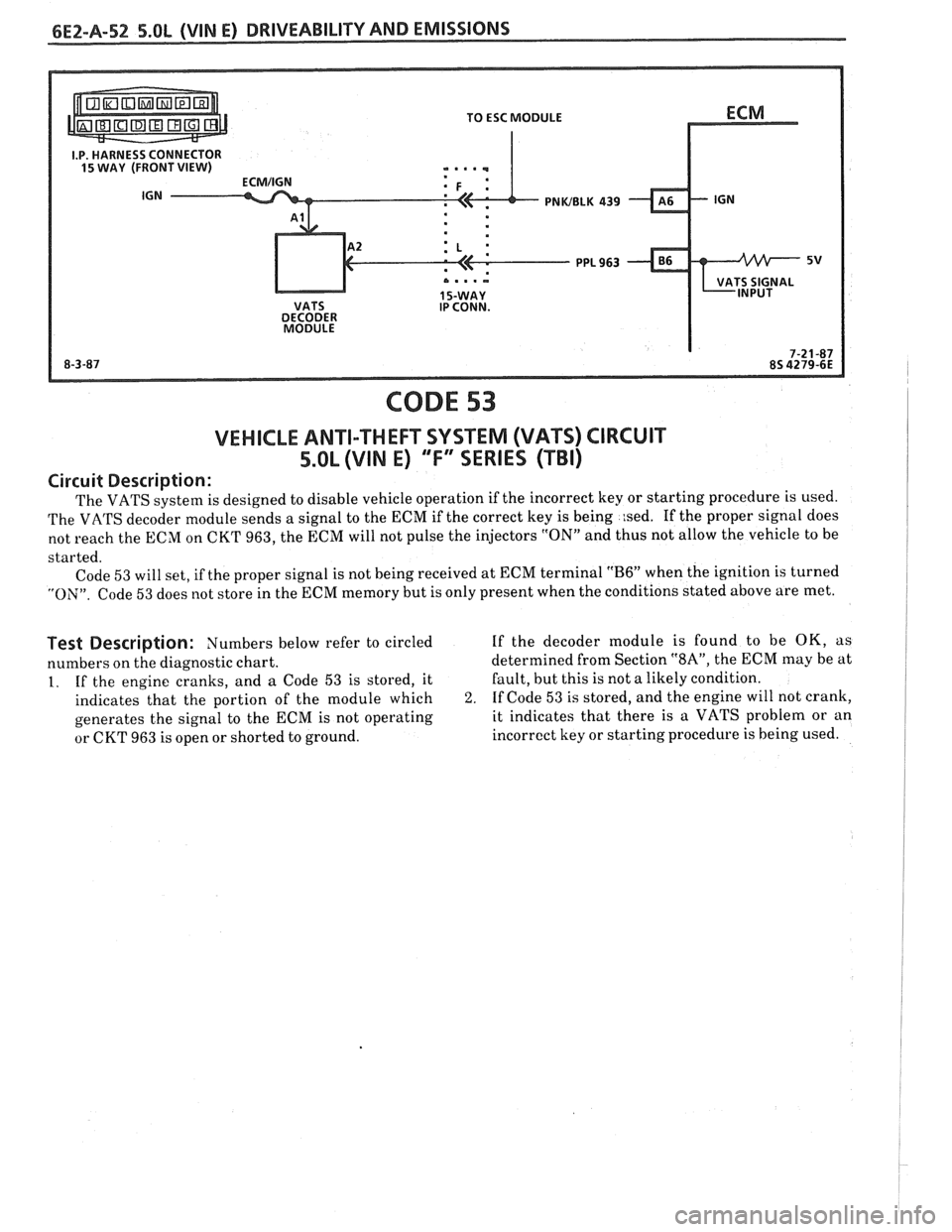
PNWBLK 439
CODE 53
VEHICLE ANTI-THEFT SYSTEM (VATS) CIRCUIT
5.OL (VIM E) "F" SERIES (TBI)
Circuit Description:
The VATS system is designed to disable vehicle operation if the incorrect key or starting procedure is used.
The VATS decoder module sends a signal to the ECM if the correct key is being
:sed. If the proper signal does
not reach the ECM on CKT 963, the ECM will not pulse the injectors
"ON" and thus not allow the vehicle to be
started. Code
53 will set, if the proper signal is not being received at ECM terminal "B6" when the ignition is turned
"ON". Code 53 does not store in the ECM memory but is only present when the conditions stated above are met.
Test Description: Numbers below refer to circled If the decoder module is found to be OK, as
numbers on the diagnostic chart. determined
from Section
"SA", the ECM may be at
1. If the engine cranks, and a Code 53 is stored, it Fault,
but this is not a likely condition.
indicates that the portion of the module which
2. If Code 53 is stored, and the engine will not crank,
generates the signal to the ECM is not operating it indicates
that there is a VATS problem or an
or CKT 963 is open or shorted to ground. incorrect
key or starting procedure is being used.
Page 545 of 1825
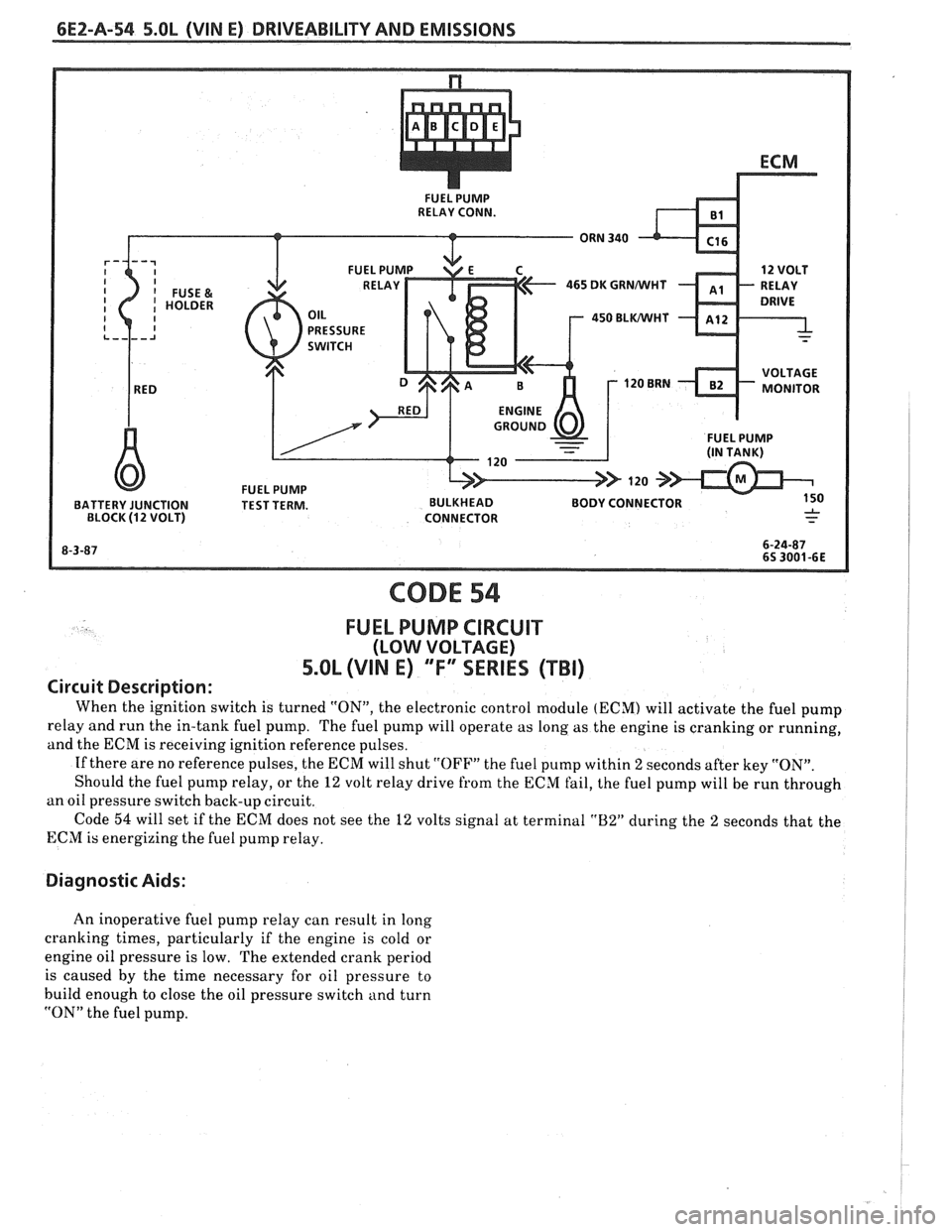
6E2-A-54 5.OL (VIN E) DRIVEABILITY AND EMISSIONS
465 DK GRNMlHT
450 BLWHT
FUEL PUMP BATTERY JUNCTION TEST TERM. BULKHEAD BODY CONNECTOR
BLOCK (12 VOLT) CONNECTOR
CODE 54
FUEL PUMP CIRCUIT
(LOW VOLTAGE)
5.OL (VIN E) "F"" SERIES (TBI)
Circuit Description:
When the ignition switch is turned "ON", the electronic control module (ECM) will activate the fuel pump
relay and run the in-tank fuel pump. The fuel pump will operate as long as the engine is cranking or running,
and the ECM is receiving ignition reference pulses.
If there are no reference pulses, the ECM will shut
"OFF" the fuel pump within 2 seconds after key "ON".
Should the fuel pump relay, or the
12 volt relay drive from the ECM fail, the fuel pump will be run through
an oil pressure switch back-up circuit.
Code
54 will set if the ECM does not see the 12 volts signal at terminal "B2" during the 2 seconds that the
ECM is energizing the fuel pump relay.
Diagnostic Aids:
An inoperative fuel pump relay can result in long
cranking times, particularly if the engine is cold or
engine oil pressure is low. The extended crank period
is caused by the time necessary for oil pressure to
build enough to close the oil pressure switch and turn
"ON" the fuel pump.